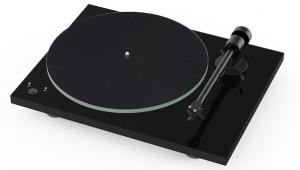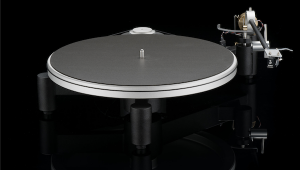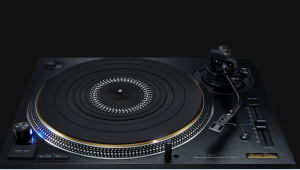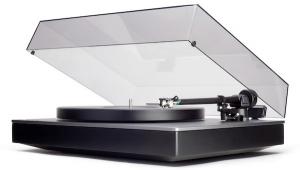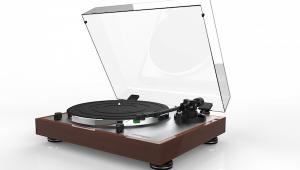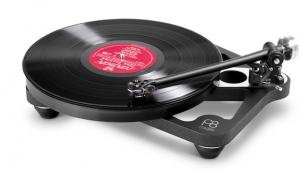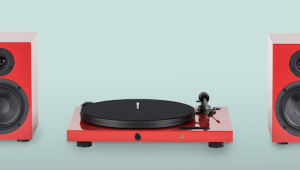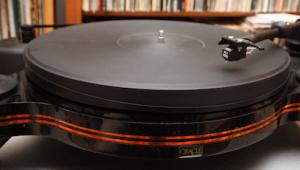VPI Classic 3 turntable & Classic-JMW tonearm

Through the years there were more modifications of VPI turntables: the extra pulleys disappeared, multiple belts were replaced by a single belt, and a flywheel provided an interface between the platter and the motor. There was even a beltless version driven by a flywheel. You can find images of "the VPI variations" online.
A few years ago, Weisfeld was apparently struck by the great sound of an old Empire Troubadour turntable whose motor was integrated into its plinth, something most designers of premium turntables long ago abandoned for what seemed obvious reasons concerning the direct coupling of noise. He built a prototype of such a design and was surprised by how great it sounded, and by how many problems the return to the old thinking could solve, assuming the motor could be properly isolated within the plinth. The result, the original VPI Classic ($2750), became one of VPI's best-selling products and is still available.
The Classic 3
The Classic 3 turntable ($6000) is the most recent VPI model, and includes some significant refinements, including a massive new plinth structure in which a ½"-thick plate of machined aluminum is bonded to a 1/8"-thick steel subplate that itself is bonded to 2" of MDF. The result is a massive, well-damped, ultra-low-resonance, 60-lb platform that sits on newly designed feet that, Weisfeld claims, produce greater stability and provide a better aesthetic match to the new plinth, which is finished in lustrous piano-black lacquer. The review sample's top plate was finished in wrinkled pebble black.
The drive system consists of an AC synchronous motor fitted with a two-step Delrin pulley that interfaces, via a rubber O-ring, with an 18-lb aluminum platter damped with a stainless-steel disc bonded to its underside. The platter rides on a pre-lubricated inverted ball bearing and a composite thrust pad.
I'm happy to see the switch of platter material from acrylic to damped aluminum; Weisfeld says the latter can be more precisely machined, and is more easily damped, more resistant to changes in temperature and humidity, and more dense. And he and I agree that it sounds better than acrylic. The Classic 3's platter is machined to accept VPI's peripheral ring clamp, which is included, as is their heavy HR-X center weight. Although the Classic 3 has been designed for the LP to be in direct contact with the platter's aluminum surface, some buyers have been using as a record mat the thin rubber mat that protects the platter surface during shipping. Weisfeld is agnostic about whether this is a good idea or not.
Most important in a turntable like the Classic 3 is how the motor is simultaneously integrated into and mechanically isolated from the plinth. Here the motor, fitted from below, is attached to a heavy plate that in turn is attached to the plinth top, but separated from it by a rubber damper. There's another rubber damper under the motor. The motor is a high-torque model, but when I placed a stethoscope against the plinth and listened, I heard virtually no motor noise.
JMW-Classic tonearm
The JMW-Classic, an upgraded version of VPI's JMW Memorial 10.5i tonearm, costs $2600 and features a new stainless-steel armtube, bearing assembly, and base mount. It is wired with Nordost Valhalla cable from the cartridge pins to the RCA jacks (XLR jacks are also available).
Since its launch, the JMW Memorial arm has undergone significant renovations that have resulted in major mechanical and sonic improvements. While the JMW-Classic retains the concept of the original, almost everything about it has been rethought and upgraded. On the original arm, azimuth was set by rotating an offset ring attached by an O-ring to the lower part of the arm's bearing-cup housing. Thus the O-ring, attached to a high mass, essentially acted as an unwelcome high-frequency spring vibrating at musical frequencies. On the JMW-Classic the azimuth is set by rotating either that ring or the counterweight. The original cantilevered bearing platform was relatively thin and unsupported. It is now far more massive and rigid, and a secondary locking support ensures rigidity. The circular mounting block of stainless steel makes possible the rigid connection of arm to plinth, and the overall design ensures a commendably low center of gravity.

What hasn't changed is the arm-rest lock—it still doesn't really lock—and, as with all "pure" unipivot arms, lateral instability remains a problem: even with damping fluid in the bearing reservoir, when I lowered the stylus to the record surface, the arm took almost 10 seconds to completely stop rocking. It looked worse than it actually was—for whatever reason, the rocking was inaudible. While the anti-unipivot lobby claims that such a design means that the arm will move in directions other than the desired lateral and vertical, I challenge anyone listening to this turntable to hear anything other than rock-solid images across the entire record surface.
VPI includes its antiskating mechanism, already attached to the mounting block for the RCA jacks. You'll need less antiskating with the JMW's 10.5"-long arm compared to a 9" arm, but I still recommend using it. VPI supplies O-rings for the antiskating lever. I'd prefer a sliding weight—the closer the O-Rings are placed to the antiskating device's pivot point, the less offset mass they provide—but that's a minor quibble.
Setup: Relatively Easy
Everything needed to set up and use the Classic 3 and JMW-Classic is in the box, including VPI's overhang jig and azimuth rod and a Shure stylus-pressure gauge. While the see-saw Shure gauge will get you close, I still think if you're going to spend $6000 on a turntable that can accommodate cartridges costing same, you should invest in a digital stylus gauge.
Remove the plinth from the shipping carton, set it atop your chosen platform, level it via the feet, place the platter atop the pre-lubed bearing, slip the O-ring over the platter and motor pulley, plug in the AC cord, and you're ready to install a cartridge. It's that easy. But before you do, you'll surely take a few minutes to admire the beauty of this turntable. In my opinion, it's the best-looking VPI ever.
The JMW-Classic arm is as easy or as difficult to set up as any pure unipivot for which azimuth is a critical parameter. If you follow the instructions and use the included tools, you'll get it close enough for enjoyment, but it can be better done with more sophisticated tools (and, of course, I recommend my setup DVD, available from the Stereophile website, which includes detailed instructions on how to set up a VPI).
The overhang jig is sufficiently accurate, but the rod method of setting azimuth will at best get the stylus perpendicular to the record, and that hardly guarantees that you've properly set azimuth. (Using this method, a small metal rod rests in a groove in the headshell. You adjust the azimuth angle so that the distance from record surface to rod is equal on both sides.) Get the Musical Surroundings Fozgometer or Dr. Feickert Analogue's Adjust+. You'll add maybe $300 to your investment, and it will be well worth it.
The Sound of Both Hands Clapping
I know what they say: "Don't knock it till you've tried it." In this case, I knocked it first. Before listening to the Classic 3, I put the stylus in a stationary record groove and did some tapping. As I've pointed out before, how a turntable responds to such an impulse doesn't necessarily indicate how it deals with sustained musical signals. The Classic 3 was definitely more lively in this regard than the essentially inert Dr. Feickert Analogue Blackbird, the last 'table to sit atop my HRS platform. Tapping either the aluminum top plate or the lacquered periphery produced a fairly loud knocking sound from the speakers. Tapping the top of the HRS platform produced an equally lively knock of much lower frequency. (Tapping the HRS rack on which the platform sat produced silence. The HRS rack works.)
Next I checked the Classic 3's speed accuracy, using Feickert's iPhone app and a test record. Each of the four grooves on the 33.33rpm pulley step produced slightly different results, as did the three on the 45rpm step. Each was relatively close to perfect, but the uppermost groove produced remarkably consistent and stable readings of from 33.30 to 33.39rpm. The lowest groove was 33.45–33.50rpm. The upper groove of the 45rpm step produced the result closest to perfect: 44.99–45.05rpm. These are superb results by any measure. So if you want perfection, find the right pulley groove and measure with a device as accurate as the free Feickert app (you'll need a test LP with a 3150Hz tone).
First up on the JMW-Classic was the Lyra Helikon SL, a lower-output version of the standard Helikon. It's fast, honest, on the analytical side, and highly detailed. If the Classic 3 sounded warm and soft, I'd know it wasn't because of the cartridge!
It's fun to play new records on unauditioned gear—you can assess the performance without prejudice. You might say that not knowing anything about the recording leaves you adrift, but if you have your system's reference sound well locked into your brain, even unfamiliar recordings will demonstrate identifiable sonic characteristics, such as excessive brightness, and mushy or overprominent bass.



